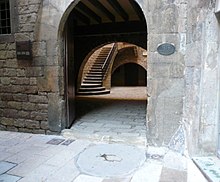Augustus Temple (Barcelona)
The so-called Augustus Temple in Barcelona was a Roman temple that was built in the settlement of Barcino (today's Barcelona). It was probably built in Augustan times on the highest point of Mont Tàber ( 16.9 msnm ). The peripteros of the Corinthian order , erected on a podium around 3 meters high , was around 35 meters long and 17.50 meters wide. The column wreath of the approximately NE-SW-facing temple had 6 × 11 columns.
With Christianization and the end of the Roman Empire , the temple lost its importance. The date of its destruction or decay cannot be reconstructed. By the 15th century at the latest, its structure, including the columns, had been built into other structures. The interpretation of three columns, initially referred to as "el Miraculum" (the miracle) from the 11th century onwards, was the subject of discussion from the 15th century onwards. Excavations in the late 19th century, for which the construction site of the Center Excursionista de Catalunya offered the opportunity, uncovered the associated podium and confirmed the interpretation as a temple, which was initially assigned to Hercules as the cult holder. A fourth column, composed of various remains, was exhibited in Plaça del Rei and added in 1956 to the structure as it can be seen today.

The entrance to the pillars is on 10 Carrer del Paradís in the Gothic Quarter ( Barri Gòtic ) of the city. In front of the entrance to the building there is a millstone and a plaque that mark the highest point of Mont Tàber.
The temple was declared a cultural asset of national interest ( Catalan Bé culture d'interés nacional ) in 1931. The "Augustus Temple" is part of the Historical Museum of the City of Barcelona (MUHBA) . Entry is free.
literature
- Pablo Piferrer, Francisco Pi Margall: España: sus monumentos y artes, su naturaleza e historia. Volume 1: Cataluña. Daniel Cortezo, Barcelona 1884, Appendix 2 ( online ).
- Josep Puig i Cadafalch : L'arquitectura romana a Catalunya. Institut d'Estudis Catalans, Barcelona 1934, pp. 94-101. 312-320.
- Juan Bassegoda Nonell: El templo romano de Barcelona. Real Academia de Bellas Artes de San Jorge, Barcelona 1974.
- Theodor Hauschild : On the typology of Roman temples on the Iberian Peninsula. Peripheral systems in Barcelona, Mérida and Evora. In: Homenaje a Sáenz de Buruaga. Institucion cultural Pedro de Valencia, Badajoz 1982, pp. 145–156, here: pp. 152–156.
- Theodor Hauschild in: Theodor Hauschild, Walter Trillmich , Annette Nünnerich-Asmus et al. (Ed.): Monuments of the Roman Age (= Hispania antiqua. Volume 5). Philipp von Zabern, Mainz 1993, p. 333 f. Plate 116. 117
- Hector A. Orengo, Ada Cortés: The Augustan Temple and Forum of the Colony of Barcino: A 90 Degree Turn , Oxford Journal of Archeology, Volume 3, Issue 1, February 2014, pages 89-107, at onlinelibrary.wiley.com, accessed on February 5, 2017
Web links
- Temple d'Augustus . Official information of the Historical Museum of the City of Barcelona (MUHBA) , accessed on January 21, 2017.
Individual evidence
- ^ Pablo Piferrer, Francisco Pi Margall: España: sus monumentos y artes, su naturaleza e historia. Volume 1: Cataluña. Daniel Cortezo, Barcelona 1884, Appendix 2 ( online ).
- ^ Columns of the "Augustus Temple" in Barcelona. irbarcelona.de, accessed on January 17, 2017 (German).
Coordinates: 41 ° 23 '0.1 " N , 2 ° 10' 37.8" E




